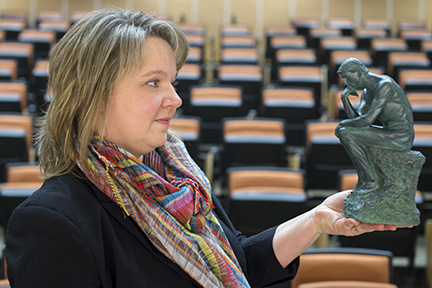
Christy Raymond-Seniuk (BScN '96, PhD '14) has thought a lot about thinking, which is a good thing-especially since her recently completed PhD studies focused on academic nurse educators' critical thinking in clinical teaching practice.
I can trace my curiosity about critical thinking and its role in nursing education back fifteen years, to 1999, when I had just started my career as a nurse educator.
There I was teaching students, future nurses, and I realized that I wasn't able to able to clearly define critical thinking. This raised a lot of questions for me and it was obvious that many of my colleagues were in the same boat and had similar questions. The concept of critical thinking is a foundation of nursing education, but as instructors, many of us struggled with how to define something so important.
Nurses are charged with the responsibility of caring for diverse individuals and populations. In promoting health within these diverse individuals, groups and families, a nurse needs to draw upon a vast knowledge base, be able to apply the applicable knowledge in complex and changing contexts and then evaluate and alter any strategies that may need to be altered in order to foster effective patient or client outcomes. Nurses make many decisions about care every day, and need higher level thinking skills to make these decisions and also to ensure those they work with are receiving the care they require.
How could I teach my students about critical thinking if even I didn't completely understand it? Since then I've spent much of time thinking about, well, thinking.
Go ahead, go critical!
You don't have to look far to see that critical thinking is an important outcome, indicator and foundational skill in nursing. In order to effectively care for complex and acutely ill individuals, as well as promote health within groups and populations, critical thinking is the vehicle for transforming thought into intentional action. Nurses' critical thinking also affects patient safety (Buerhaus, Donelan, Ulrich, Norman & Dittus, 2005) and is vital for nurses to become key leaders in healthcare.
As nurses we need to think creatively and with certain standards of thought such as clarity, depth, comprehensiveness and relevance. These standards along with the breadth of knowledge we think about encompasses the complexity of thought required in our role.
Nursing education plays an integral role in the development of students' critical thinking. An important component of nursing education is nurse educators and the methods they use to help students attain key skills and abilities for practice. We need to know more about how nurse educators can use their own critical thinking to foster students' critical thinking.
There are many reasons why critical thinking is important in nursing education. Critical thinking is the foundation for careful and effective decision making in complex health case situations. Robert and Petersen (2013) indicated that critical thinking goes beyond complex decision making and involves efficiency and effectiveness in one's thinking.
Teaching students to think critically in their nursing education prepares them for the realities of the role and the changing nature of a complex practice environment. Alongside the cognitive skills associated with critical thinking, there are also dispositions or attitudes associated with thinking critically such as open-mindedness, inquisitiveness and confidence. Critical thinking dispositions are equally important and support the ability of practitioners to use their thinking skills. The combination of both skills and abilities is integral to one's ability to effectively navigate complex patient care situations.
Building on the foundation
During my Master of Education studies I started to explore the critical thinking of nurse educators. I built upon that research and continued to further advance what we know about nurse educators' critical thinking in my doctoral work, which investigated how academic nurse educators reveal their critical thinking when working with students in the clinical setting. Educators role model many integral nursing skills in clinical practice when interacting with students and surprisingly, there has been limited research exploring how critical thinking can be role modeled.
I believe the critical thinking of nurse educators is an important factor influencing the educational experience for students. That being said, there is very limited research exploring nurse educators' critical thinking. How can we foster it in our role as educators if we don't know we have it ourselves?
My findings revealed that the nurse educators I studied were not initially aware of the ways they mobilized their critical thinking. Nevertheless they were role modeling their critical thinking in diverse and complex ways. I believe the key is to make those ways intentional and explicit.
My research findings also indicated that critical thinking dispositions are often more visible to an observer than the less discernible cognitive activity associated with critical thinking. There is an interplay between discernible and indiscernible activities that encompass nurse educators' critical thinking. Students will look to see how critical thinking is exemplified in that environment by their instructor or educator. If the instructor isn't sure how they exemplify it, neither will the student.
Additionally, nurse educator participants' had similar critical thinking skill and disposition measurements compared to the other limited nursing studies in this area. For example, nurse educators have habitually scored higher on the inquisitiveness critical thinking subscale. This tells us that there may be a similar trend of more commonly found dispositions in nurse educator populations that need to be better understood.
A small but growing number of studies exploring nurse educators' critical thinking have also told us that there are some similar moderately strong critical thinking skill subscale scores in this population. This is encouraging and needs further study to see what factors affect why nurse educators score higher in critical thinking compared to students.
Finding a piece of the puzzle
Based on my research findings, I was able to develop a model depicting how nurse educators reveal their critical thinking to students in the clinical setting. This model showed the inter-related discernible and indiscernible ways nurse educators' revealed their critical thinking. The model also explained the role of barriers and facilitators of nurse educators' critical thinking in the clinical setting and how resources were used to support their critical thinking in the practice setting.
A key finding from this model was the need for the student and educator to connect interpersonally in a mutually respectful way that furthered student learning. Without establishing a common place of mutual understanding, students were not receptive to witnessing nurse educators' critical thinking and educators were more likely not to show their critical thinking in those interactions. It was like a synergistic connection where students felt safe, respected and wanted to learn more. It was a palpable place of possibility where educators and students could interact for the betterment of each student's developing nursing practice. It was from this view point that students were witness to the specific methods such as questioning and thinking out loud that nurse educators employed to show their thinking.
As an educator and researcher I learned a lot about critical thinking from this study. Not only the process of studying it but of the concept itself. My participants were so willing to share their time and thoughts with me. They truly made this study by their willingness to learn. From the interactions I had with them and the results I saw emerge in this study, I think nurse educators would benefit from an opportunity to further develop how to think about their thinking in deep and reflective ways and how this can be maximized for student learning.
Where do we go from here?
 My grandfather was 101 years old when he passed away earlier this year. He wasn't an academic; he was a wise, yet simple man. He believed that you died when you stopped learning, and he passed that belief on to me.
My grandfather was 101 years old when he passed away earlier this year. He wasn't an academic; he was a wise, yet simple man. He believed that you died when you stopped learning, and he passed that belief on to me.
Despite the common belief that critical thinking is important, there is still much to be learned about what it entails, how it is learned and how it is used in action. The term critical thinking has been a catchphrase for many years without a clear understanding of its complexity and full realm of application. Although we have heard much about critical thinking and believe that deeper more reflective thought is necessary, the concept of critical thinking still remains somewhat immature in its development (Turner, 2005) and requires continued exploration.
As well as learning more about the concept of critical thinking in nursing education, attention should also be on the importance of how we reach the desired outcome of critically thinking nursing graduates who are better able to practice effectively in diverse health settings. Nurse educators are pivotal in nursing education. Continued focus is needed on how to foster nurse educators' authentic, purposeful, intentional teaching practice and how each nurse educators' own critical thinking impacts how safe, effective learning environments are facilitated.
I remember those educators along my journey who have inspired me to think - I could do so not only from how I saw them do it but also the environment they purposely created. Those are the educators that I admire and want to role model my practice after. I want to be that educator for other students and help other educators reach those goals in their practice.